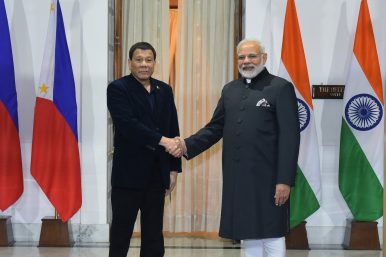
Image Credit: Flickr/ Indian Ministry of External Affairs
The 61-year old Treaty of Friendship signed in Manila on July 11, 1952 between India and the Philippines was cemented again by Philippine President Rodrigo Duterte as he attended the India-ASEAN Commemorative Summit in New Delhi hosted by Indian Prime Minister Narendra Modi. Duterte and Modi exchanged economic and political views, including discussing the possibility of military cooperation. The defense relations of the two maritime nation-states have been marked by frequent visits by Indian navy warships and coast guard ships to the Philippines since 1998 and thereafter in 2017 under the terms of the 2006 Philippines-India Defense Cooperation Agreement.
Being natural allies — English-speaking democratic stalwarts with shared experiences of Western colonialism — India has supported the Philippines’ positions on quite a few international issues, including world trade, labor, and even the latter’s quest in 2004 to become a nonpermanent member of the UN Security Council from 2005 to 2006, when India withdrew its candidacy in favor of the Philippines. In 2011, the Philippines also supported India, as the latter was elected to the rotating two-year membership in the Security Council. For more than a decade, the Philippines and India have continuously held bilateral negotiations assessing their progress on trade, investment, economic, technical, scientific, and technical cooperation. With the world’s exponential growth in digitization and globalization, both countries have emerged as frontline service sectors in the business process outsourcing industry.
The renewed relationship has cemented almost 40 bilateral agreements and memoranda of understanding, alongside several rounds of mutual visits by top leaders, and people -to-people exchanges that have enhanced ancient trade and cultural ties. Amidst the volatile geopolitical and strategic ambiguities in the Indo-Pacific region, New Delhi’s expanding defense posture and economic success can provide prospects for shaping the balance of power in the region.
After the arbitral tribunal’s verdict over the South China Sea case filed by the Philippines against China, India used its influence among Asian neighbors to push for peaceful resolution of maritime differences. As a naval power itself, India had a moral responsibility to push for freedom of navigation as a global interest, asserting that no state has a monopoly over the seas and oceans. India hopes that assertions of maritime and international laws will prevail in maintaining an equitable balance of powers in an evolving multipolar world.
Both the Indian and Filipino navy and air force should help provide a secure maritime environment. Given the volatility of the regional security environment, the Philippines should learn from India in enhancing transparency and accountability while pursuing opportunities for stable security structures. The Armed Forces of the Philippines should opt to improve its human, organization, and information capital. It shall build a culture of joint operations, establish an integrated secure communications and information system to institutionalize integrated joint logistics support systems, and develop a professional and highly motivated regular and reserve force. Highly competent and motivated professionals should spearhead the crafting of sound and appropriate maritime doctrines leading to responsive naval reserve forces; the same professionals should be building the corps of the same force.
Meanwhile, India’s financial aid and growing counterterror cooperation during the Marawi siege in Mindanao manifest an Asian big brother’s determination to halt terrorism in the region. The Philippines can also learn from India about the peaceful resolution of armed conflict. After the Sino-Indo territorial sovereignty dispute caused war in 1962, the thorny border issue was largely stabilized in 1996 through an agreement to resolve regional security threats.
Indian defense technology is admittedly more advanced than the Philippines’. Along with India’s tremendous economic growth, it has optimized the production of computer software operating short- and intermediate-range ballistic missiles, nuclear capable aircraft, naval vessels, and India’s active military space program. Duterte’s strategic visit to New Delhi, should gauge the possibilities for new engagement on defense. Both countries can benefit from a much closer cooperation in the development and application of aviation and space technology including telecommunications, television broadcasts, meteorological services, disaster warnings, and surveillance satellites. In the short run, with India’s strong naval aviation, it can assist the Philippines with defense research and technology transfer, especially relating to naval ship design and repairs, helping Manila to maintain stability in the high seas and combat transnational crimes and terrorism.
The Philippines and India should join hands and engage each other on many fronts. Given all the confidence and potential each country has, they must strategically continue to gauge assistance and learn best practices from each other in the fields of defense infrastructure, industry development, business process outsourcing, life sciences, research technology, higher education, agriculture, and medicine — especially since both Asian democratic countries share similar values.
[Dr. Chester Cabalza is a security analyst.]
https://thediplomat.com/2018/01/the-philippines-strategic-relationship-with-india/
No comments:
Post a Comment
Note: Only a member of this blog may post a comment.